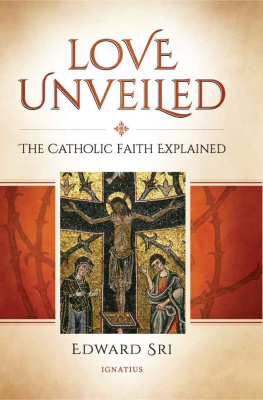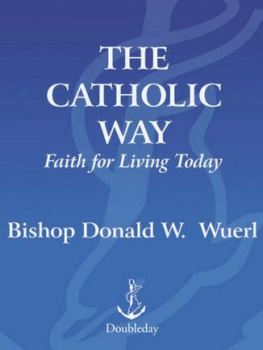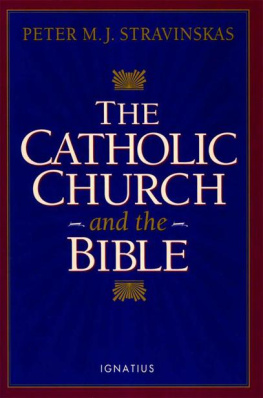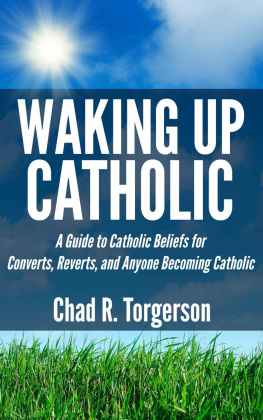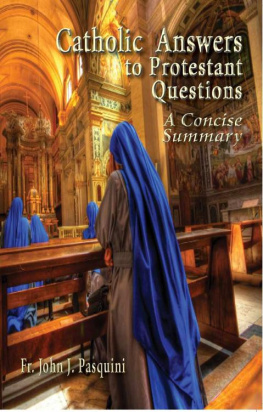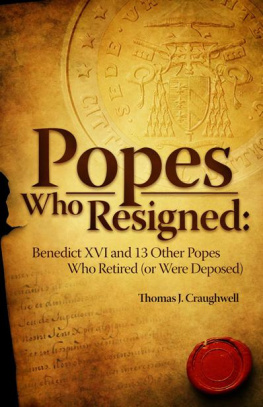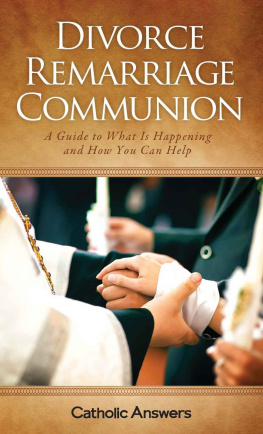Annulments and the
Catholic Church
Straight Answers to Tough Questions
Edward N. Peters, J.D., J.C.D.
Foreword by
Most Reverend John J. Myers, D.D., J.C.D.,
Archbishop of Newark

West Chester, Pennsylvania
Copyright 2004 Ascension Press, LLC.
Revised edition. All rights reserved.
With the exception of brief excerpts in critical reviews or articles, no part of this work may be reproduced in a form whatsoever, printed or electronic, without the prior written permission of the publisher.
Ascension Press
Post Office Box 1990
West Chester, PA 19380
Orders: 1-800-376-0520
www.AscensionPress.com
Cover design by Kinsey Caruth
Printed in the United States of America
07 08 09 10 11 12 9 8 7 6 5 4 3
ISBN 978-1-932645-00-2
A CKNOWLEDGMENTS
Although the deficiencies in this book are entirely mine, its strengths draw from many sources. I am grateful to Drs. Robert Kennedy and Thomas Green of the Catholic University of America, who taught me how to read the Churchs marriage law with precision and insight; to Msgr. Joseph Sadusky of the Archdiocese of Washington, who provided the best tribunal internship a student could hope to have; and to Bishop Roger Schwietz, OMI, and Fr. Dale Nau of the Diocese of Duluth, who first assigned me to tribunal duties and who patiently explained many things I should have already known. Many friends, though especially Mark Brumley, M.T.S., Fr. Joseph Koterski, S.J., and the team at Ascension Press, made suggestions that improved the revised edition of this work. Most of all, though I am grateful to Bishop Robert Brom and to the entire staff of the Tribunal of the Diocese of San Diego who, along with the appellate judges of the Province of Los Angeles, made sure that I learned something new about marriage and ministry every day.
sections and this should assist those who are confused by a particular aspect of the process. Included is general information about annulments and about the various officials involved. The information provided on the possible grounds for an annulment should help clarify some often-asked questions. Often, people seeking annulments have complicated questions. Some typical ones are included by Dr. Peters, and these questions will help the reader identify their own situation in the examples given.
A few sections in particular should be highlighted as being highly valuable. Many works on annulments ignore the possibility that the process could end in a negative response. Dr. Peters includes insightful information for those who do receive a negative decision. Inclusion of this material acknowledges the reality of the canonical process, prepares the reader for that possible outcome, and may assist those who are frustrated or dismayed after having received a negative sentence. Another valuable section includes questions for those who are not seeking an annulment but who are nonetheless involved in the process. These include former spouses and parties who are called upon to be witnesses. Helpful information is provided for these parties, who may be confused as to why they are being requested to provide information.
The annulment process combines the difficult task of upholding Our Lords strong teaching on marriage, yet extending his mercy to those whose former marriages might have been sacramentally null. Annulments and the Catholic Church: Straight Answers to Tough Questions should prove to be a highly valuable resource for those interested in this delicate area.
Most Reverend John J. Myers, D.D., J.C.D.,
Archbishop of Newark
xiii
I NTRODUCTION
Each year more than a hundred thousand people, including thousands of non-Catholics, are directly involved in the Churchs annulment process. Several times that numberfamily members and friendsare affected by the decisions reached in annulment cases. All of these people, to say nothing of observers from the Catholic and the non-Catholic world, have questions about annulments. Most of the questions contained in these pages derive from those posed to me as a canon lawyer, tribunal official, and teacher over the years. Indeed, I have found that peoples questions touch on almost every significant aspect of the annulment process, and so it was not difficult to cover most of the key issues in a question-and-answer format. I have tried to answer these questions as I would address someone sitting in my officethat is, simply and accurately. There are, though, two advantages to answering annulment questions in writing: First, I can add a few extra details to written answers, usually concerning things that people are likely to pose as follow-ups to their original question; second, I can give references to the canon numbers upon which my answers are based. Obviously, I think the answers in this book are correct, but if one wishes to disagree with them, at least it will be clear why I said what I said. Speaking of being clear, I have avoided technical terms as much as possible in these pages, but this is a technical field and precision comes with technical terminology. Major terms are defined in the Glossary.
This book can be read front-to-back, since the questions generally proceed in the same order in which they arise during a typical annulment case. The Index, on the other hand, allows for consultation on a topical basis, since there is no need to explain earlier issues if only the later ones are causing confusion.
A word of caution: Do not take this book and try to analyze your own marriage, or your parents marriage, or your childrens marriages, or your friends marriages (see Question 100). Do not take it to a pastor or tribunal judge and say, See? It says right here this annulment must be granted (or denied). Because this book does not say that.
Every annulment case is heard under the same set of laws, but no two annulment cases present anything like the same set of facts. The information in this book is provided in the context of a specific question, but even these questions exist in a larger and more complex context. This is why judging is both a science and an art.
In any event, it should be obvious that this book is designed neither to encourage more annulment cases nor to discourage them. Actually, this book couldnt do either, since the canon law under which annulment cases are adjudicated is already in force, and the facts assessed in an annulment case are already in place before a canon lawyer ever sees them. To put it another way, the information in this book can be used legitimately by some people to advance annulment petitions they desire and by others to resist annulment petitions they oppose. My hope in both situations is to help the people involved in or affected by the annulment process to understand the process better and to participate in it more effectively. If this, in turn, helps to ensure that the decisions reached by diocesan tribunals in annulment cases are as accurate as possible, I shall be satisfied.
Dr. Edward Neal Peters
N OTES
- 1983 CIC means 1983 Code of Canon Law ( Codex Iuris Canonici ), promulgated by Pope John Paul II in 1983 and currently in force. The number(s) immediately following 1983 CIC refer to the actual canons of the 1983 Code. All canonical references in this work are to the 1983 Code of Canon Law unless expressly stated otherwise.
- 1917 CIC means 1917 Code of Canon Law ( Codex Iuris Canonici ), promulgated by Pope Benedict XV in 1917 and no longer in force. The number(s) immediately following 1917 CIC refer to the actual canons of the 1917 Code.
- Unless otherwise noted, diocesan and archdiocesan institutions follow the same rules in marriage nullity cases.
Next page


